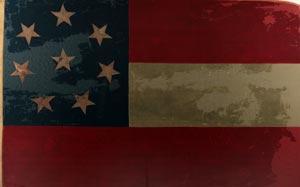The Civil War in Missouri
Save ThisMy CollectionLife of Missouri Confederates and Missouri State Guard

- The Missouri State Guard (MSG) was created by the pro-South governor Claiborne Jackson to drive Union troops from Missouri.
- When that effort failed, many pro-South Missourians joined the Confederacy.
Supplies
Highlights
- The MSG’s clothing came from wherever they could get it. Some uniforms were donated, others were purchased by the quartermaster, and others came from soldiers’ homes.
- In 1861, units of the MSG were enlisted in Confederate service. These troops had slight improvements in their clothing and supplies. Clothing continued to be a problem as uniforms quickly got dirty and damaged in battle.
- Access to food and supplies varied depending on the time of the war and where soldiers were stationed.
In Depth
The Missouri State Guard’s clothing often came from wherever they could get it. Some uniforms were donated, others were purchased by the quartermaster, and others came from soldiers’ homes. William Bull in a letter home described how he would like his uniform to look, saying, “I want it made of gray cloth, the coat double breasted, MO buttons if they can be had if not federal staff buttons.”
In 1861, units of the Missouri State Guard were enlisted in Confederate service. These troops had slight improvements in their clothing and supplies. They were given new uniforms and belts inscribed with “C.S.” Shotguns were replaced with muskets. Clothing continued to be a problem as uniforms quickly got dirty and damaged in battle.
Edward Scott, a Missouri Confederate, described the food he ate as “bakers bread, sugar, molasses, rice, beef, and bacon”. He went on to say that they had plenty to eat. Food was not always so plentiful, however, as Captain Eathan Allen Pinnell described: “We have nothing to eat but beef without salt which we boil over the fire and half rations of flour which we make as dough in our handkerchiefs and back on sticks it is rather rough for a commencement but I shall never murmer if it is never worse.” He described shortages in supplies, including tents, saying, “Received of the quartermaster three small inferior tents, the first I have received for my company. We have been in service for four months and eleven days.”
Soldier Life
Highlights
- Camp life for a Missouri Confederate was much the same as for his Union counterpart. Drills and inspections filled much of the day.
- When not in camp, soldiers were often on the march. Lack of supplies could make marches brutal, as Captain Pinnell describes: “Marched twenty three miles over a fertile and heavily timbered country…. Day very cold and many of the men barefooted.”
- The final aspect of the soldiers’ life was combat. In all, 27,000 Missourians (Confederate and Union) lost their lives in the war.
Vocabulary
Fertile - capable of producing vegetation.
Primary Sources

